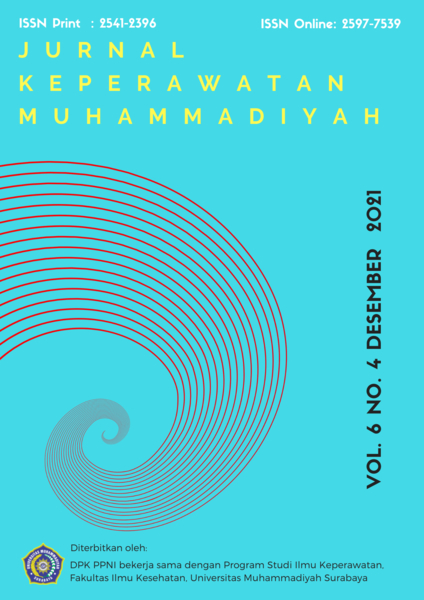Pengaruh Pendampingan Ibu Nifas terhadap Risiko Kejadian Depresi Postpartum di Praktik Mandiri Bidan Kota Surabaya
DOI:
https://doi.org/10.30651/jkm.v7i2.12937Keywords:
Mentoring, Postpartum, DepressionAbstract
Objective: Â The postpartum period is the period experienced by women after the baby is born until the reproductive organs return to normal conditions as before pregnancy within six weeks. During the postpartum period, there are several phases of a woman's adjustment to her role as a new parent which can cause anxiety, especially for women who are giving birth for the first time because they do not have experience caring for babies. A mother who cannot adjust to her role as a parent can experience psychological disorders with various symptoms known as postpartum depression. Postpartum depression is a severe and persistent mood change experienced by a woman after childbirth and can last for several months or even a year or more.
Methods: Â This study is a quantitative study with a quasi-experimental design through pre and post-measurements in the intervention group and control group. The intervention carried out for postpartum mothers was assistance four to 4 times by midwives and in the control group, services were provided according to the standards of postpartum mother visits.
Results: Â The results showed that the group that was assisted was mostly not at risk for postpartum depression, which was 64%, while the control group did not receive assistance. Most of them are at risk of postpartum depression, which is 72%. And based on the results of the Independent Sample T-Test, it was found that the value of p = 0.012 (<0.05) means that there is an influence of mentoring on the risk of postpartum depression.
Conclusion: Â Mentoring given to postpartum mothers affects the incidence of postpartum depression risk, where postpartum women who are assisted tend not to be at risk of postpartum depression, and mothers who are not assisted tend to be at risk of postpartum depression.References
Bentelu, F. E. ., & Kundre, R. (2015). Perbedaan Tingkat Kecemasan Dalam Proses Menyusui Antara Ibu Primipara dan Multipara di RS Pancaran Kasih GMIM Manado. e-journal Keperawatan, 3, 1–27.
Bobak, L. (2005). Dasar-Dasar Keperawatan Maternitas. EGC.
Esha Pradnyana, Wayan Westa, N. R. (2018). Diagnosis dan Tata Laksana Depresi Postpartum Pada Primipara. SMF Psikiatri Fakultas Kedokteran Universitas Udayana, 283.
Forster, D. A., McLachlan, H. L., Davey, M. A., Biro, M. A., Farrell, T., Gold, L., Flood, M., Shafiei, T., & Waldenström, U. (2016). Continuity of care by a primary midwife (caseload midwifery) increases women’s satisfaction with antenatal, intrapartum and postpartum care: Results from the COSMOS randomised controlled trial. BMC Pregnancy and Childbirth, 16(1), 1–13. https://doi.org/10.1186/s12884-016-0798-y
Hasri, H. (2015). Perbedaan Tingkat Kecemasan Dalam Proses Menyusui Antara Ibu Primipara Dan Multipara Di RS Pancaran Kasih GMIM Manado. e-journal Keperawatan (e-Kp), 3, 6.
Kirana, Y. (2015). Hubungan Tingkat Kecemasan Postpartum Dengan Kejadian Post Partum Blues di Rumah Sakit Dustira Cimahi. Jurnal Ilmu Keperawatan, III(1), 1–13. https://ejournal.bsi.ac.id/ejurnal/index.php/jk/article/view/150
Kusumawati, P. D., Damayanti, F. O., Wahyuni, C., & Setiawan, A. (2020). Analisa Tingkat Kecemasan Dengan Percepatan Pengeluaran ASI Pada Ibu Nifas. Journal for Quality in Women’s Health, 3(1), 22/10/2020 Pukul 12:45 WIB. https://doi.org/10.30994/jqwh.v3i1.69
Latifah, L., & Hartati. (2006). Efektifitas Skala Edinburgh Dan Skala Beck Dalam Mendeteksi Risiko Depresi Post Partum Di Rumah Sakit Umum Prof. Dr. Margono Soekarjo Purwokerto. Jurnal Keperwatan Soedirman (The Soedirman Journal Of Nursing), 1(1), 15–19.
Lowdermilk, D. L. (n.d.). Management of Discomfort.
Machmudah. (2015). Gangguan Psikologis Pada Ibu Postpartum ; Postpartum Blues. Keperawatan Maternitas, 3(2), 118–125.
Marniyati, L., Saleh, I., & Soebyakto, B. B. (2016). Pelayanan Antenatal Berkualitas dalam Meningkatkan Deteksi Risiko Tinggi pada Ibu Hamil oleh Tenaga Kesehatan di Puskesmas Sako , Sosial , Sei Baung dan Sei Selincah di Kota Palembang Pendahuluan menjadi peserta Jaminan Kesehatan Nasional Pemerintah Propi. Jurnal Kedokteran dan Kesehatan, 3(1), 355–362.
Nagle, C., Skouteris, H., Hotchin, A., Bruce, L., Patterson, D., & Teale, G. (2011). Continuity of midwifery care and gestational weight gain in obese women: A randomised controlled trial. BMC Public Health, 11(1), 174. https://doi.org/10.1186/1471-2458-11-174
Nasri, Z., Wibowo, A., & Ghozali, E. W. (2017). Faktor Determinan Depresi Postpartum di Kabupaten Lombok Timur Determinants Factors of Postpartum Depression in East Lombok. Buletin Penelitian Sistem Kesehatan, 20, No. 3, 89–95.
NHS England. (2017). Implementing Better Births: Continuity of Carer. NHS, 07342, 1–35.
Ningsih, D. A. (2017). Continuity of Care Kebidanan. OKSITOSIN : Jurnal Ilmiah Kebidanan, 4(2), 67–77. https://doi.org/10.35316/oksitosin.v4i2.362
Nugraheni, herlina tri. (2017). Hubungan Kehamilan Usia Dini Dengan Kejadian Postpartum Blues Di Rsud Wonosari Tahun 2017. Poltekkes Kemenkes Yogyakarta.
Solehati, T., Sriati, A., & Kosasih, C. E. (2020). Intervention To Reduce Post-Partum Depression. Jurnal Keperawatan Jiwa, 8(2).
Suparmi, S., Masitoh, S., Rizkianti, A., Maisya, I. B., Saptarini, I., Susilowati, A., Sugiharti, S., Lestary, H., Novianti, N., Pambudi, J., Amaliah, N., Rosha, B. C., Putri, I. Y., Sari, K., Rachmalina, R., Puspita, F. D., Marina, R., Putro, G., Soekotjo, N. E. W., … Nurmansyah, M. I. (2020). Pendampingan Mahasiswa Dan Peningkatan Pengetahuan Ibu Hamil Tentang Tanda Bahaya Kehamilan, Nifas Dan Bayi Baru Lahir Di Tujuh Kabupaten/Kota Di Indonesia. Jurnal Ekologi Kesehatan, 18(3), 192–200. https://doi.org/10.22435/jek.v3i18.2307
Texas Department of State Health Services. (2016). Postpartum Depression Among Women Utilizing Texas Medicaid. October. https://hhs.texas.gov/sites/default/files/Postpartum-Depression-Among-Women-Utilizing-Texas-Medicaid.pdf
Widarini, Y. I. P., Arifah, I., & Werdani, K. E. (2020). Analisis Faktor Risiko Gejala Depresi Pada Ibu di Masa Nifas di Kecamatan Banjarsari, Surakarta. Buletin Penelitian Kesehatan, 48(2), 131–138. https://doi.org/10.22435/bpk.v48i2.2872
Witteveen, A. B., De Cock, P., Huizink, A. C., De Jonge, A., Klomp, T., Westerneng, M., & Geerts, C. C. (2016). Pregnancy related anxiety and general anxious or depressed mood and the choice for birth setting: A secondary data-analysis of the DELIVER study. BMC Pregnancy and Childbirth, 16(1). https://doi.org/10.1186/s12884-016-1158-7
Downloads
Published
Issue
Section
License
- Penulis tetap memegang hak atas karyanya dan memberikan hak publikasi pertama kepada jurnal ini yang secara simultan karya tersebut dilisensikan di bawah:Â Creative Commons Attribution-ShareAlike 4.0 International (CC BY-SA 4.0)













